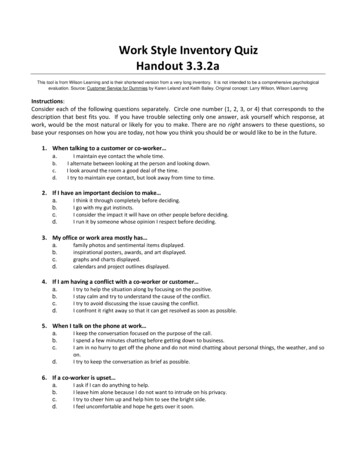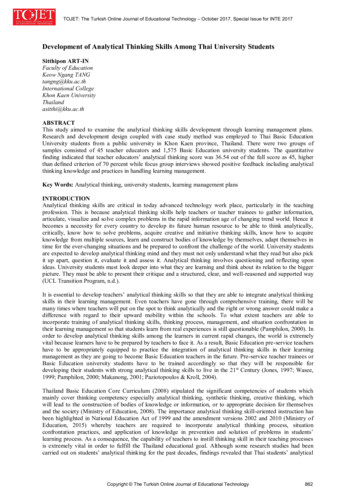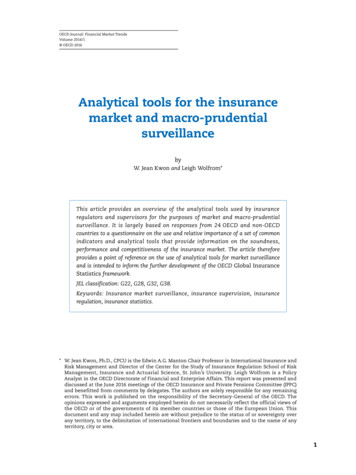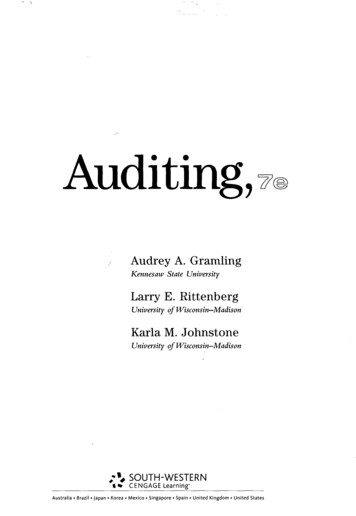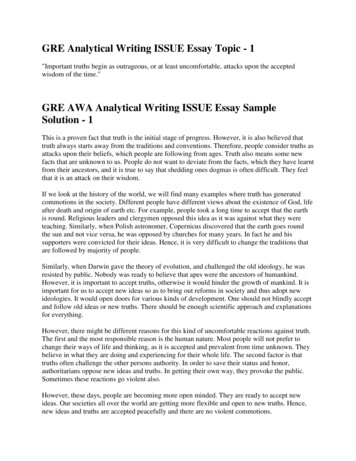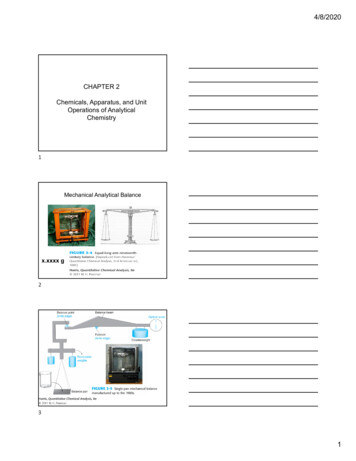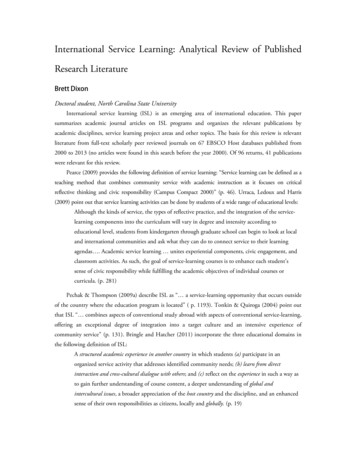
Transcription
International Service Learning: Analytical Review of PublishedResearch LiteratureBrett DixonDoctoral student, North Carolina State UniversityInternational service learning (ISL) is an emerging area of international education. This papersummarizes academic journal articles on ISL programs and organizes the relevant publications byacademic disciplines, service learning project areas and other topics. The basis for this review is relevantliterature from full-text scholarly peer reviewed journals on 67 EBSCO Host databases published from2000 to 2013 (no articles were found in this search before the year 2000). Of 96 returns, 41 publicationswere relevant for this review.Pearce (2009) provides the following definition of service learning: “Service learning can be defined as ateaching method that combines community service with academic instruction as it focuses on criticalreflective thinking and civic responsibility (Campus Compact 2000)” (p. 46). Urraca, Ledoux and Harris(2009) point out that service learning activities can be done by students of a wide range of educational levels:Although the kinds of service, the types of reflective practice, and the integration of the servicelearning components into the curriculum will vary in degree and intensity according toeducational level, students from kindergarten through graduate school can begin to look at localand international communities and ask what they can do to connect service to their learningagendas . Academic service learning unites experiential components, civic engagement, andclassroom activities. As such, the goal of service-learning courses is to enhance each student’ssense of civic responsibility while fulfilling the academic objectives of individual courses orcurricula. (p. 281)Pechak & Thompson (2009a) describe ISL as “ a service-learning opportunity that occurs outsideof the country where the education program is located” ( p. 1193). Tonkin & Quiroga (2004) point outthat ISL “ combines aspects of conventional study abroad with aspects of conventional service-learning,offering an exceptional degree of integration into a target culture and an intensive experience ofcommunity service” (p. 131). Bringle and Hatcher (2011) incorporate the three educational domains inthe following definition of ISL:A structured academic experience in another country in which students (a) participate in anorganized service activity that addresses identified community needs; (b) learn from directinteraction and cross-cultural dialogue with others; and (c) reflect on the experience in such a way asto gain further understanding of course content, a deeper understanding of global andintercultural issues, a broader appreciation of the host country and the discipline, and an enhancedsense of their own responsibilities as citizens, locally and globally. (p. 19)
Brett DixonPagano and Roselle (2009) note the importance of subject matter, practice and context:The international context of an international internship or service learning program is one of themain elements that allow students to develop a mental model of the world. The construction ofknowledge is then based on a triad - subject matter, practice, and context. We need to design andassess experiential education with careful attention to these three elements. (p. 218)Bracci, Bella Owona and Nash (2013) state: “ reflection represents the link between experience andlearning and unites the two opposite poles of acquisition: the academic and the experiential. Throughreflection the student creates her own understanding with an intercultural perspective” (p. 200).Eyler (2011) presents service learning outcomes which include social and community engagement,academic and intellectual development, and personal outcomes. Metcalf (2010) offers insight on someoutcomes and benefits of service learning:Community service learning projects encourage not only the development of competenciesrelated to specific business disciplines but also broader work-related competencies, such as crossfunctional thinking, teamwork, interpersonal interaction, communication, and multiculturalsensitivity . (p. 155)Types of International Service Learning Programs by AcademicDisciplines and Project AreasHealth Care (18 articles)Community Health, Nursing and Midwifery. Reisch (2011) recommends the following forhealthcare programs based on a review of literature and her experiences with a program in Nicaragua:1. Require pre-trip knowledge of cultural, historical and social issues, 2. Recipient communityidentifies its own needs, 3. Define clear objectives and use established outcomes measures, 4.Require at least minimum proficiency in the local language, 5. Manageable group size, 6. Facultysupervision during the provision of care, 7. Allow limited tourism activities, 8. Establish clearstandards for student behavior, 9. Emphasis on sustainability and continuity of program. (p. 98)Curtin, Martins, Schwartz-Barcott, DiMaria and Ogando (2013) present a qualitative descriptiveresearch study of a two-week nursing program for senior baccalaureate students at the University of RhodeIsland to provide health care with a non-profit organization in rural Dominican Republic. Before theprogram, participants took part in seminars on the Dominican health care system, politics, culture,language and history, a one day-long orientation, and had assignments. After the program, they took partin seminars for reflection on their experiences and provided feedback. Curtin et al. (2013) note, “With theincrease in the diversity of the population, health care institutions are seeking nurses who possess theknowledge and skills in providing culturally and linguistically competent care” (p. 549). The program’saim was to develop students’ intercultural nursing care, self-reflection and foreign language ability. Curtinet al. (2013) describe the program’s design: “This component of the framework includes four areas of108
Brett Dixonlearning to promote student development of attitudes, knowledge and skills for engagement in globalhealth: global learning, international service learning, and social consciousness, global cultural competenceand country-specific knowledge” (p. 551). Students took part in activities at a rural clinic, an adult dayhealth program, a head start program and a pre-natal and well child clinic, did reflection and groupdebriefing sessions and wrote daily journal entries. Results from thematic analysis of the participants’journals showed commonalities in the following five themes: increasing cultural awareness, adaptingphysically, increasing confidence in speaking Spanish and assessing health problems, shifting focus fromself to other, and encountering frustration in the ability to fully meet patients’ needs.Kohlbry and Daugherty (2013) present four faculty roles related to the design and implementationof nursing projects (initiator, collaborator, facilitator and advocate), and illustrate these roles through aprogram run by California State University San Marcos in Mexico. The initiator discusses opportunitiesand ideas for nursing projects with other faculty. The collaborator generates involvement by connectingwith other people and organizations. As facilitators, faculty involve students in activities and guide themthrough the reflection process. As advocates, faculty inform others of service learning’s value andencourage participants to present their experiences at conferences.Main, Garrett-Wright and Kerby (2013) present the results of a qualitative study of nine WesternKentucky University undergraduate and graduate nursing students who participated in the Belize Projectin Gales Point, a rural village. Students, professional staff and faculty took part in a two-day pre-departureorientation and did team building exercises. During the project, students provided medical services to thecommunity and participated in cultural activities. Analysis of journal entries revealed eight themes:1) expectations and emotions regarding the trip, 2) developing a reciprocal relationship with thecommunity, 3) valuing interdisciplinary collaboration, 4) acquiring knowledge that would impacttheir future nursing practice, 5) growing personally, 6) making future plans to continue doingservice work, 7) recognizing themselves as part of a larger social network and a sharedresponsibility for social problems, and 8) buying into the interdisciplinary change projects.(Main, Garrett-Wright & Kerby, 2013, p. 10)Main, Garrett-Wright and Kerby (2013) note: “The findings indicate that international servicelearning opportunities increase students’ awareness of their place in a global society and the potentialcontribution they can make in society” (p. 10).Riner and Becklenberg (2001) review Indiana University School of Nursing’s partnership with theBloomington, Indiana-Posoltega, Nicaragua Sister City International (SCI) organization. Students workedwith local health care professionals and offered prenatal classes to lay midwives and community healthcare workers during trips in 1998 and 1999.Larson, Ott and Miles (2010) describe a two-week experience in Guatemala in May 2008 as part of acultural immersion course by student nurses at a university in North Carolina. The course includedseminars on political, economic, social and health issues of Mayan communities. In Guatemala studentsundertook intensive Spanish language study and participated in community health clinical practice. Theaim of the research was to examine the effect of the cultural immersion on participants’ cultural109
Brett Dixoncompetence. Larson, Ott and Miles (2010) cite others on the importance of developing culturallycompetent nurses:Developing culturally competent nurses is imperative, as the Hispanic/Latino population isprojected to reach 29% of the U.S. population by 2050 . Currently, the vast majority of nursesidentify as non-Hispanic White , and many have had limited experience with diverse ethnicand racial groups (p. 44).Analysis of students’ reflective journals revealed themes of making contributions through communityservice, making connections between U.S. policies and poverty and experiencing living conditions neverseen or imagined before.Walsh (2003) discusses a two-week midwifery and nursing program involving nursing students fromthe University of San Francisco in San Lucas Toliman, Guatemala, a community of mostly Mayans livingin extreme poverty. The university developed a collaborative relationship with the San Lucas Tolimancommunity aimed at improving the skills and knowledge of indigenous midwifes living in an area withlimited resources and high infant and maternal mortality rates. Participants raised funds for supplies forthe community and attended preparatory seminars. During the experience, students and a faculty memberassisted midwives in providing prenatal care. Participants conducted training sessions for staff at prenatalclinics and attended a workshop which examined Mayan beliefs on health-related practices. Evaluationsshowed that students increased their sensitivity and awareness of women and families living in a differentculture, and developed an understanding of poverty in developing countries, an appreciation fortraditional birth attendants’ skills and knowledge in providing reproductive health care (Walsh, 2003).Dharamsi et al. (2010) present a phenomenological report of three University of British Columbiamedical students’ experiences in eight-week international projects. Two students worked in Kampala,Uganda on the development of a “sustainable community-based child-to-child project” (Dharamsi et al.,2010, p. 978) and the third student taught in a nursing program in Dhaka, Bangladesh. Preparation forthe experience involved discussions of socially responsible approaches and ethical issues related tovolunteering in under-resourced contexts. The aim was to explore the value of critical reflection as apedagogical approach in enhancing the students’ understanding of the Canadian Medical EducationDirections for Specialists (CanMEDS) Health Advocate Role. Dharamsi et al. (2010) describe this role:The health advocate role (RCPSC 2005) requires physicians to respond to the needs of“vulnerable or marginalized populations.” It stipulates that physicians have a “duty to improvethe overall health of their patients and the society they serve to assist them in navigating thehealth care system and accessing the appropriate health resources in a timely manner ” (p. 977)Students wrote accounts of their experiences in reflective journals which were analyzed. Dharamsi etal. (2010) state:Our study suggests that preparing the next generation of physicians to attend to the CanMEDSHealth Advocate Role – “the ethical and professional issues inherent in health advocacy,including altruism, social justice, autonomy, integrity and idealism” – requires a pedagogical110
Brett Dixonapproach that enables experiential learning and critical reflection . Upon completion of theISL experience, the students revealed an increasingly meaningful sense of what it means to bevulnerable and marginalized, a heightened level of awareness of the social determinants of healthand the related importance of socially responsible approaches to community engagement, and adeeper appreciation of the health advocate role. A key outcome of the ISL project was thedevelopment of the students’ capacity to reflect on and cultivate their role as health advocates. (p.980)Plumb et al. (2013) present studies of partnerships between Thomas Jefferson University (TJU) andpartners in Rwanda and San Jose State University (SJSU) and partners in Mexico. Since 2006, 65 ThomasJefferson students have participated in three to eight-week experiences in Rwanda. TJU has partnered withvarious groups on community building and public health education projects in Rwanda. SJSU haspartnered with organizations and agencies in Oaxaca, Mexico since 2005. More than 100 SJSU publichealth and health science students have participated in four or nine-day experiences in Oaxaca.Participants’ experiences in these Rwanda and Mexican projects have demonstrated their development in anumber of global health competencies (Plumb et al., 2013).Kiely (2004) presents a longitudinal case study of 22 participants who took part in one of fivecohorts of an international service learning program in Nicaragua between 1994 and 2001. Manyparticipants were enrolled in a two-year nursing program. The program’s aim -was assisting members ofthe local community with the organization and implementation of health clinics. Students also engaged inresearch in the community. The study found that each student had a change in world-view but those whostated a desire to alter their lifestyle and work toward social justice faced challenges in their efforts to acton their beliefs and desires.Health and Dental Care. Tabor, Carter, Kovar and Ramsing (2008) briefly note a programdeveloped by faculty at Western Kentucky University focused on providing healthcare and preventivedental care services in Belize. Students worked with patients in Creole and Mayan villages, kept dailyjournals and took part in community events. Tabor et al. (2008) note that participants reported beinginspired toward greater involvement in their own communities and increased self-confidence.Green, Comer, Elliott and Neubrander (2011) describe a group of health care students from threeU.S. universities who served in remote villages in Intibuca, Honduras on a ten-day program. Participantsconducted clinics and provided care for tropical diseases and problems associated with contaminated waterand malnutrition. The study aimed to determine the experience’s effect on participants’ culturalcompetence. Green et al. (2011) describe its importance as follows:As the population of the United States becomes increasingly diverse, health care providers mustlearn to care for and communicate effectively with people from a variety of cultural backgrounds.To understand and respond to the needs of culturally diverse patients, health care providers mustpossess the skills and insight to overcome barriers in language and differences in beliefs, values,and customs. (p. 302) [ ] Another important value that resulted from the strong feeling ofconnection with the people they encountered was a sense of reciprocity. The experience gave111
Brett Dixonparticipants the feeling that they were both giving and taking. They were able to give to acommunity in tangible ways, providing much-needed health care, dental care, and healtheducation, and in other ways, for example, contributing as a group to a scholarship fund thatenabled some local children to go to school beyond the sixth grade. In return, they received anincomparable learning experience, a sense of accomplishment, an opportunity to hone theirnursing skills, and the gratitude of the local people. (p. 306)Quantitative results of the study found that participants’ cultural competence moved to a higherlevel. Exit interviews revealed the following themes: “a) stepping outside my world, b) connecting withculturally different people, c) awe of community, and d) learning innovation” (Green et al., 2011, p. 305).Results suggest that participation was instrumental in increasing participants’ ability to give culturallycongruent care (Green et al., 2011).Puri, Kaddoura and Dominick (2013) discuss an experience to Morocco by students from twoinstitutions in the northeastern part of the United States. Students distributed oral health care products,cared for underserved people and led oral health care clinics. Participant interviews revealed the followingmajor themes: professional growth as a health care provider, motivation to serve underserved countries,bridging inter-cultural gaps and the urban-rural divide, and bridging theory-practice gap (Puri, Kaddoura& Dominick, 2013).Amerson (2012) presents a study of 14 nursing students at a public university who took part in amedical mission to Guatemala and Ecuador in either 2006, 2007 or 2008 as part of a community healthnursing course. Preceding each trip a faculty member led weekly preparatory sessions. The faculty memberand students accompanied a “non-profit, non-denominational, Christian-oriented organization” on eachtrip (Amerson, 2012, p. 8). Students worked with a multidisciplinary group to provide medical and dentalcare in rural communities and participated in daily faculty-led discussions on their experiences. Studentsparticipated in a group project to present a poster presentation at a research forum. Amerson (2012)elaborates: “The daily experiences provided opportunities for the students to recognize common healthproblems, practice communication in Spanish, observe the environmental issues which impacted health,and witness the impact of severe poverty in lesser-developed countries” (p. 9). Participant interviewsexamined how participation influenced their transcultural self-efficacy and subsequent nursing practice(Amerson, 2012).Physical Therapy. Hayward and Charrette (2012) describe a study involving physical therapydoctoral students which is modeled on the combined cultural competence frameworks developed byCampinha-Bacote and Purnell and aims to integrate experience-based learning and culturally competentcare. Hayward and Charrette (2012) explain the importance of cultural competence in physical therapy:Cultural competence is important because a successful patient provider interaction may beimpeded when the respective parties are from different ethnic or cultural (cross-cultural)backgrounds Effective care requires an understanding of the patient’s values, family structure,life roles, and culture Providers without the skills for working in cross-cultural situations mayexperience difficulty communicating effectively with either patients or family members, which112
Brett Dixonmay result in improper management of the diseases or conditions characteristic of a particularpopulation. (p. 79)The program included a short-term experience at an orphanage in Quito, Ecuador where studentsprovided physical therapy care to children living there. In preparation, students took Spanish courses,participated in reflective journaling and cultural awareness activities and researched Ecuadorian culture.Hayward and Charrette (2012) report positive change in students’ professional skills awareness and astatistically significant post-intervention “Emotional Resilience” score. Hayward and Charrette (2012)conclude, “Our model enabled students to be immersed within a culture, realize the core values in action,develop cultural competence, and solidify their interest in working with pediatrics and internationallywith underserved populations” (p. 78).Pechak and Thompson (2009b) provide rationale for physical therapy ISL programs:Growing ethnic and cultural diversity within the United States demands increased focus onopportunities for physical therapists to gain cultural competence to provide optimal rehabilitativecare to varied clients. Concurrently, increases in the number of persons with disabilitiesworldwide and unmet needs for rehabilitation challenge the physical therapy profession to expandits global role. Incorporating international service-learning or other international volunteer serviceopportunities into physical therapist education curricula may address these needs by fostering thepreparation of culturally competent practitioners capable of engagement in the global healtharena. (p. 71)Pechak and Thompson (2009b) surveyed physical therapist education program directors in theUnited States and Canada to find out faculty perceptions of benefits of and barriers to ISL programs. Thefollowing is the frequency and location of programs in the previous ten years: Caribbean (16), CentralAmerica (11), Mexico (5), South America (5), Africa (3), Asia (4), Europe (3), Australia (2), Middle East(1) and the United States (1) (Pechak and Thompson, 2009b). Program cost and lack of time and fundingfor faculty were the greatest perceived barriers. Development of cross-cultural competence and studentpersonal development were noted as the greatest benefits (Pechak and Thompson, 2009b).Pechak and Thompson (2009a, 2011) conducted a survey of established US-based physical therapisteducation programs with ISL components in order to identify an optimal program model. Five phases inthe process of developing an optimal ISL physical therapist education program emerged: development, design,implementation, evaluation and enhancement. Four main themes (structure, reciprocity, relationship andsustainability) were identified in these five phases.Engineering (4 articles)Solar Water Pump System. Borg and Zitomer (2008) describe a project to provide a solar-poweredwater pumping system to provide clean water for an orphanage in Guatemala. Two teams of engineering113
Brett Dixonstudents from Marquette University participated in the project. Borg and Zitomer (2008) relate theimportance of clean water:At any given time, more than half of the developing world’s population is suffering from one ormore of the main diseases associated with unsafe water and poor sanitation . The WorldHealth Organization (WHO) estimates that more than 16% of the world’s population (1 billionpeople) do not have access to safe water and over 2 billion people live without adequate sanitation . Every day world wide, 6,000 children die of water-related diseases. Most of those who diecould be saved with inexpensive and simple solutions. (p. 178)Objectives of the project included expanding engineering students’ international, cultural and socialexperience through service to others. Students applied technical knowledge learned in their engineeringcourses in the context of rural Guatemala’s history, economy and culture. Students developed team skills,appreciation for professional and ethical responsibility and heightened understanding of contemporaryglobal issues. Borg and Zitomer (2008) describe the project’s impact on students:The juxtaposition of the various realities, including living conditions and opportunities, culturesand conflicts, rich and poor, expand students knowledge of multicultural contemporary issues,make students aware of the impact an engineering solution can have in societal or global context,and promotes professional and ethical responsibility. (p. 183)Water Distribution System. Budny and Gradoville (2011) discuss the development of theUniversity of Pittsburgh’s first humanitarian engineering project. Fourth-year civil engineering studentstook part in a project in Tingo Pucará, a small village located in the central highlands of Ecuador at almost13,000 feet. Budny and Gradoville (2011) point to the benefits of service learning for engineeringstudents:The service-learning aspects introduce the concept of engineering as a tool for helping society, theimportance of understanding customer needs, and introduce an invaluable depth to theexperience of engineering. An international experience early in the professional career is excitingand stimulating, as the most basic assumptions in our daily lives are challenged, including thoseconcerning language and culture. Those moments, when students’ senses are peaking, areopportunities for transformational educational impacts that can have ripple effects on their futurelives and careers. (p. 100)It was decided to design a water distribution system for delivering water to village homes, whichwould give the students experience in project management, engineering design in a resource-limitedenvironment through humanitarian engineering and international development. The University’s CivilEngineering faculty collaborated with Engineers without Borders, the US Peace Corps, the non-profitBuilders Beyond Borders, the Ecuadorian government and members of the village of Tingo Pucará on theproject. Budny and Gradoville (2011) point to the strengths of this collaborative effort:The engineering department did not try to manage all aspects of this community developmentproject. The technical engineering aspects were handled by engineers, while the funding,114
Brett Dixoncommunity organization, and materials acquisition was largely handled by other groups. Thismay serve as a model for other engineering departments interested in similar projects, but wary ofthe multidisciplinary responsibilities of undertaking such a project. (p. 113)The students designed the water distribution system and traveled to the site in Ecuador to begin itsconstruction. A survey of all fourth-year engineering students who worked on design projects showed theISL project generated greater understanding of engineering in global and societal contexts and encouragedstudents to act altruistically.Water Treatment and Distribution System. Plumblee, Cattano, Bell and Klotz (2012) describeClemson University students’ participation in Clemson Engineers for Developing Countries’ (CEDC)ongoing project in Cange, a rural village in the Central Plateau of Haiti, which involves the design andconstruction of a water treatment and distribution system for Cange and neighboring areas. Plumblee etal. (2012) note the value of ISL for engineering students:Service learning projects outside of the United States encourage a more global perspective inengineering students . By witnessing these problems firsthand and interacting with thecommunity, students gain a deeper awareness of global issues such as water availability, poverty,and mass unemployment. Furthermore, students better understand the importance of theircontribution to the community stakeholders. (p. 47)Plumblee et al. (2012) note the challenges of working on a project in an area ravaged by a naturaldisaster as when Haiti was devastated by an earthquake on January 12, 2010:As a result of the earthquake, the CEDC student teams in Haiti faced numerous challenges thatare unique to working in an international environment. Coordination with internationalorganizations was required to ensure the safety of the team traveling to Cange. Building materialsand supplies required for even the most basic reconstruction efforts were not readily available.CEDC tries to maximize the use of local labor and materials to support the community’seconomic activity. However, the local labor force often is not sufficiently trained to interpretdesign documents or execute complex construction operations . Facility design documentsmust be crafted to ensure that all construction can be accomplished with hand tools becauseheavy construction equipment is not available. (p. 50)Outcomes of student involvement are presented in communication, teamwork, globalization andleadership (Plumblee et al., 2012).Coffee Wastewater Treatment Facility Design. Marsolek et al. (2012) discuss a wastewatertreatment design project for a coffee processing mill in La Sauna, a rural community in Nicaragua,involving civil and environmental engineering students from Seattle University. The students worked witha faculty member whose project aimed to “place scientific and technical expertise in service to the smallscale Nicaraguan coffee producer” (Marsolek et al., 2012, p. 70). The project involved collaboration withSeattle University’s Science and Engineering Project Center, Coffee for Justice Project, regionalagricultural cooperatives, development agencies and local communities and farmers. Marsolek et al.115
Brett Dixon(2012) summarize the project and student learning outcomes:From a service learning point of view, the project was an unqualified success. A team ofengineering students put their capstone design project into direct service to a poor community inthe developing world. These students traveled to Nicaragua, interviewed the clients, and designedoptions for them that were technically sound, of appropriate technology and culturallyacceptable. The students also saw their design actually built and implemented. They learned theimportance of effective
that ISL " combines aspects of conventional study abroad with aspects of conventional service-learning, offering an exceptional degree of integration into a target culture and an intensive experience of community service" (p. 131). Bringle and Hatcher (2011) incorporate the three educational domains in the following definition of ISL:

